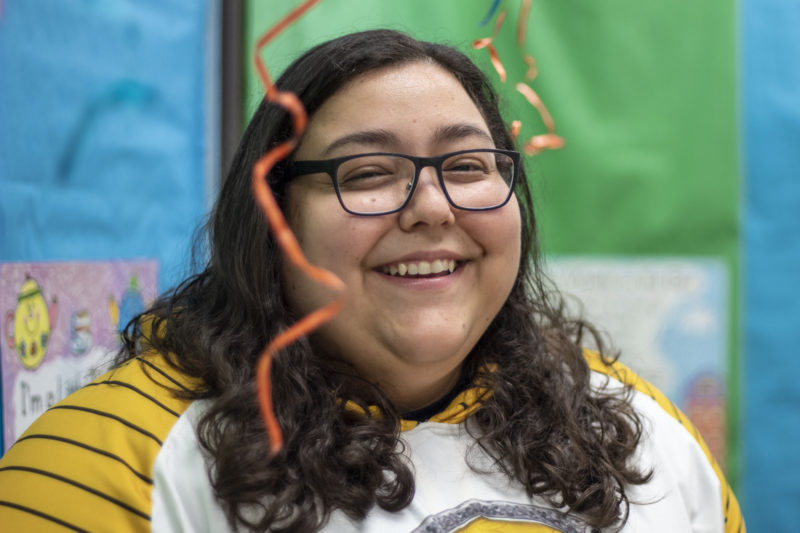Austin Teachers Say They Face High Levels of Work-related Stress
By Hope Lenamon
Reporting Texas
On a Thursday in November, more than 20 Austin Independent School District teachers and staff members trickled into a South Austin office building to attend a meeting of Education Austin, the district’s teacher’s union. After greeting each other with hugs and discussing plans for the upcoming holiday season, the conversation got serious.

Karen Reyes, a special education teacher, said she struggles with balancing her mental health and her personal life. Erika Ramirez/Reporting Texas
The teachers vented about the issues they face day in and out — preparing students for high-stakes standardized tests, working long days for low pay and managing student behavior. The educators agreed on what has become a hard truth in schools around the nation — increasing levels of work-related stress make it difficult to effectively do their jobs and have caused some to consider leaving the field.
“We have teachers in places that are expected to change the world and no tools, resources or salaries to justify the work that’s required,” Ken Zarifis, president of Education Austin, said prior to the meeting.
Zarifis, who taught English at Austin’s Burnet Middle School for a dozen years, said that in addition to long hours and an intense focus on testing, managing the emotional needs of up to 30 students contributes to the pressure that teachers face.
“These things all add up to enormous stresses that I don’t think very many people understand outside of the classroom,” Zarifis said.
American educators reported being always or often stressed at work 61% of the time, according to a 2017 survey conducted by the American Federation of Teachers and the Badass Teachers Association. Other workers reported the same levels of stress only 30% of the time. In Texas, the survey found 74% of educators and school staff reported their work is often or always stressful.
Teacher stress is linked to high turnover, which in turn can result in lower achievement for students and higher costs for school districts, according to a 2016 report from Penn State University.
Teaching has a national turnover rate of about 8% annually, about twice as high as other high-achieving countries including Finland, Singapore and Canada, according to a 2017 report from the Learning Policy Institute. Austin ISD has seen about a 10% turnover rate every year since 2011.
“How do you ever establish a safe and stable learning environment for kids, and a safe and stable working environment for teachers?” Zarifis asked. “You don’t. It’s always in flux. It’s disruptive.”
Paul Tapp is an attorney of the Association of Texas Professional Educators, an organization that provides resources and legal aid to educators and advocates for public education. Tapp said the association has received an unusually high number of calls from educators seeking a way to terminate their contracts because of high levels of stress.
In efforts to reduce teacher turnover, districts around the nation are beginning to offer programming aimed at helping teachers’ deal with work-related stress. In 2011 Austin ISD started a Social & Emotional Learning Department which, according to the department’s website, helps children and adults develop skills such as recognizing and managing emotions, developing empathy, establishing positive relationships and handling challenging situations constructively.
James Butler, a former kindergarten and pre-K teacher, was voted Austin ISD Teacher of the Year in 2014. Butler started working as the school district’s mindfulness expert in the Social and Emotional Learning Department in 2016. He said his personal experience with PTSD, anxiety and depression led to his passion for teaching mindfulness, an approach to manage thoughts and feelings by using mind-body techniques such as breathing exercises, yoga and meditation.
Teachers are often so selfless in providing for students that their own mental health can suffer, he added.
“Teaching requires so much of us that if we’re not truly taking care of ourselves, we’re not being our best selves for our students,” Butler said. “If we’re not taking care of ourselves we can’t do our job.”
Zarifis said that while he understands the importance of social emotional learning, for teachers, it becomes another thing teachers have to manage in an already busy day.
“Where’s the social emotional learning for adults? Because don’t you dare tell me I’m not doing enough for the kids if you’re unprepared to do it for me.”
Butler said being one of the first districts in the nation to implement districtwide social and emotional learning came with major learning curves. When the program started it focused on students. It wasn’t until a few years passed that the need to expand the program to help teachers became apparent.
Austin ISD is one of 20 districts partnered with The Collaborative for Academic, Social, and Emotional Learning —an organization that supports educators and policy leaders in social and emotional learning practices in schools. Dallas and El Paso are the only other Texas’ school districts also partnered with the organization.
“I really try to stress this isn’t something extra to do,” Butler said. “Find ways to integrate this into your life, into your classroom, and to help with transitions.”
In an email sent to Austin ISD employees, educators were given several tips for caring for themselves more effectively including: setting healthy boundaries, taking short breaks every hour and exercising.
Karen Reyes, a special education teacher at Linder Elementary in Austin, said it seems like the district’s idea of mental health wellness for teachers is too focused on quick fixes, like meditation. She said asking teachers to take a break every hour is a nice thought but unrealistic.

Karen Reyes said there is an immense amount of pressure on teachers, and the school district doesn’t have a functional program to help them cope with mental health issues when they come up. Erika Ramirez/Reporting Texas
Reyes added much of educators’ stress comes from being overworked and under paid, and that if the district wants to be serious about mental health a systemic change needs to be made from the administration down to students.
“We’re all humans. We all have lives. Lives are stressful,” Reyes said. “You can’t just keep adding more programming and more things. We’re not robots. Let people have what they need to be healthy both in body and mind and in overall wellness. The district can do a better job about that.”
Employee well-being is a priority for the district, Eddie Villa, AISD communications specialist, said via email. The district offers mental health services for employees, including free counseling sessions and legal and financial consultations. AISD has one of the highest utilization rates — more than 17% — in the state for such services, Villa added.
Zarifis said districts could help their teachers by taking as much of an interest in providing the best environment for their mental health as they expect teachers to do for students.
“A great teaching environment is a good learning environment,” Zarifis said. “What has happened is that we forgot about the grownups in the public school system.”